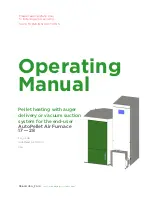
IO-213D
2/04
7
WARNING
THE AREA SURROUNDING THE VENT TERMINAL AND
COMBUSTION AIR SUPPLY PIPE MUST BE KEPT FREE
OF SNOW, TRASH, BUSHES OR ANY OTHER OBSTACLE
WHICH COULD CAUSE
CARBON MONOXIDE
TO ENTER
THE BUILDING.
SUPPORTING AND PITCHING THE VENT AND
COMBUSTION AIR SUPPLY PIPE.
All horizontal runs must be supported at least every five (5)
feet and at joints with straps or hangers. No sags or dips
are permitted. The pipes must be saddles supported only.
Do not secure the hangers or straps tightly to the pipes to
allow for expansion and contraction of the vent pipe.
Maintain a 1/4" per foot minimum pitch upward on the
horizontal vent pipe from the drain to the terminal. This will
allow the condensate to flow into the drain system and not
out the terminal. Vertical runs must be supported a
minimum of every six (6) feet.
The combustion air supply pipe should be pitched slightly
downward at the inlet to prevent water from entering the
pipe.
VENT
COMB.
AIR
12"
MIN
12"/2" DIA.
14"/3" DIA.
GAS
WATER
HEATER
ALTERNATE
INSTALLATION
COMB. AIR
VENT
VENT TERMINATION
When the horizontal vent option is used the vent pipe is to
be terminated with a “Tee” fitting. A debris screen (packaged
with the furnace) is to be installed on each open end of the
termination tee. When vertically vented no termination fitting
is required. However, to accoradate the debris screen, a
coupling is to be attached to the end of the vent pipe. The
debris screen is to be glued into the coupling.
JOINING PIPE AND FITTINGS
Proper installation of the vent/combustion air system is
critical to safe operation of this product. Carefully read and
understand the instructions in this section. Do not connect
to an existing vent or chimney.
Provisions are made for the connection of outside
combustion air to the furnace casing. This connector may
be moved to the opposite side of the furnace by removing
the screws securing the collar, removing the large plug on
the side of the furnace and reconnecting both.
The plastic plugs must be in place when installed as a direct
vent unit.
When utilizing indoor air for combustion in unconfined spaces,
it is not necessary to connect any pipe to the collar. It is
recommended that the plug is removed and both sides be
used for supplying combustion air.
When installed in the horizontal position in unconfined
spaces, a short length of pipe, a coupling and the screen
must be in place, facing up or the air may be obtained from
the bottom of the unit providing there is at least 4" of
unobstructed space. It is recommended that the plug is
removed and the combustion air supply is obtained from both
openings.
A pitch of 1/4" per foot toward the drain assembly is
recommended for proper drainage.
The GMNT series of gas furnace is a condensing type
appliance. The products of combustion are recirculated
through a secondary coil. During this process, the flue
products are brought to a temperature below dew point. Thus
the moisture present in the flue products condense, leaving
a liquid by-product. This by-product must be removed from
the furnace and it’s collection system. In addition, the vent
temperatures are also considerably lower than conventional
furnaces. This allows the use of low temperature plastic as
the vent system. The recommended material is schedule 40
PVC, DWV, ABS (or equivalent if allowed by local code).
FOAM CORE PIPING MUST NOT BE USED.
See previous chart for proper sizing. The drain trap and
related parts must be installed as shown in the illustrations
located elsewhere in these instructions. Failure to follow
these instructions can cause products of combustion
including
CARBON MONOXIDE
to enter the building. This
appliance may be horizontally vented through an exterior
wall. See the illustrations located elsewhere in this manual.
IF THIS FURNACE IS INSTALLED ABOVE AN OCCUPIED
OR SIMILAR AREA WHERE CONDENSATE OVERFLOW
MAY BE A PROBLEM AN AUXILIARY DRAIN PAN MUST
BE INSTALLED UNDER THE FURNACE WITH THE
AUXILIARY DRAIN LINES ROUTED TO THE OUTDOORS
TO PREVENT WATER DAMAGE CAUSED BY LEAKS.
The vent pipes must be inspected annually.
Visually check the vent terminal and combustion air supply
pipe. Clean if necessary.
Visually check for blockage of the condensate disposal
system. Hoses may be disconnected to determine that proper
flow is maintained. Should an obstruction be observed, it
can be dislodged by forcing a stream of water through it
using a device such as a garden hose.
This appliance may be vertically or horizontally vented.
Horizontal venting requires a 90
o
long sweep elbow be installed
as the vent terminal. This elbow is to be installed discharging
downward and the factory supplied termination screen is to
be attached. This elbow must be located no less than 12"
above grade or expected snow levels. To prevent damage to
the vent pipe and its terminal, the distance from the terminal
to the exiting wall is to be the minimum practical distance
(within 12" would be acceptable).
Vertical venting does
not require a terminal
. If desired, the vent may be faced






































